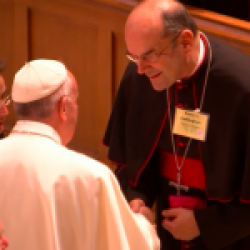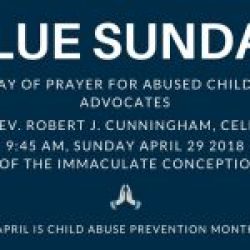The newly ordained Father Robert J. Cunningham celebrates his first Mass at St. John the Baptist Church in Kenmore on May 25, 1969. (Photo provided)
By Katherine Long | Editor
Though the young Robert J. Cunningham first started thinking about becoming a priest when he was in fourth grade, it may have been a moment with his bishop a few years later that moved him to heed the call.
“When I was in seventh grade, the assistant pastor in our parish, Father John Collins, died,” the now Bishop Cunningham recalled in a recent interview with the Sun. “The kids all loved Father Collins. He taught me how to be an altar boy.”
Fittingly, Bishop Cunningham served Father Collins’ funeral Mass, which was celebrated by Bishop of Buffalo Joseph Burke.
“Part of the ritual of that time was when the bishop came in the sacristy, the first thing he did was wash his hands,” Bishop Cunningham said. He and his fellow altar server kneeled down to wash the bishop’s hands and Bishop Burke “said to us — I can remember it clearly — ‘Father Collins has died. And one of you should be a priest and take his place.’”
As Bishop Cunningham marks 50 years as a priest and 10 years as the Bishop of Syracuse, he spoke with the Sun to take a look back on his years of ministry and ahead to his next chapter.
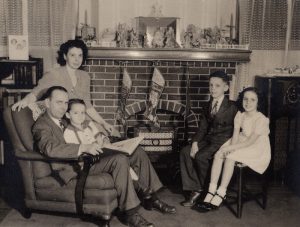
A Cunningham family Christmas card. Pictured are Cecil, Grace, Patrick, Eileen, and Robert (on Cecil’s lap). (Photo provided)
Born June 18, 1943, Robert was the youngest of Cecil and Grace Cunningham’s three children. He grew up in Kenmore, a suburb of Buffalo, where in the afternoons he’d walk his neighborhood delivering the Buffalo Evening News. More than half of that neighborhood, he recalled, was Catholic.
“The parish played a huge part in our lives,” he said of his home parish, St. John the Baptist Church. “Not just the religious [aspect], but the social and athletic” — and the educational.
All of the Cunningham children attended the parish grammar school. The classes were very large, he remembered, with 50 or 60 children each. In all but one grade, he was taught by a Sister of St. Mary of Namur.

The young Robert Cunningham. Photo provided)
After his initial thoughts of a vocation in fourth grade and the encouragement from Bishop Burke in seventh grade, Bishop Cunningham got a final nudge in the eighth grade.
“My pastor, Msgr. [Charles] Klauder, had, along with an assistant pastor… suggested that I might want to go to the prep seminary,” he said.
The next fall, he joined 80 other young men in the freshman class at the Diocesan Preparatory Seminary.
One of those young men was Paul Burkard, now a monsignor and pastor of Our Lady of Victory National Shrine and Basilica in Lackawanna.
“We met the first day of high school… and we were in the same classroom, I think, the entire time the next 12 years,” Msgr. Burkard said with a laugh. Alphabetical seating kept them close in the classroom, but they were close outside the classroom as well, often working on homework together via phone in the evenings.
Msgr. Burkard remembers Bishop Cunningham as very studious and a bright student. “He was always a good friend, not only to me but to a lot of people,” he said. The two remain friends and still catch up by phone every week.
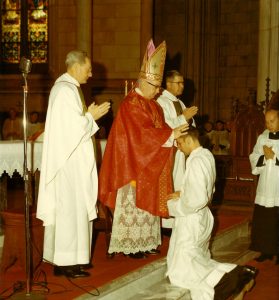
Father Robert J. Cunningham is ordained a priest of the Diocese of Buffalo by Auxiliary Bishop Bernard McLaughlin at St. Joseph Cathedral in Buffalo on May 24, 1969. (Photo provided)
After six years at the prep seminary, Bishop Cunningham went on to major seminary at St. John Vianney Seminary in East Aurora. Following six years of studies there, he was ordained a priest of the Diocese of Buffalo on May 24, 1969.
Bishop Cunningham was among 24 men ordained for the diocese that day. The ordinands were divided into three groups of eight; Bishop Cunningham’s group was ordained by Auxiliary Bishop Bernard McLaughlin at the “new Cathedral,” St. Joseph in Buffalo.
It was a sunny spring day but cold in the cathedral, he recalled. Ordination brought “a wonderful feeling of having achieved, in a sense, a goal, but at the same time anticipation of looking forward to the future and what it would hold,” he said.
The new priest’s first assignment arrived in the mail about two weeks later: associate pastor at Blessed Sacrament Church in Kenmore, where Bishop McLaughlin was pastor.
Bishop Cunningham was the third assistant at the parish, where about 1,600 families belonged. His ministry included teaching in the parish school, visiting the sick, and assisting with youth programming.
“I enjoyed the variety of parish life,” he said, citing ministry to the sick as especially fulfilling. “When I thought of priesthood, that’s what I thought I would be doing.”
In 1972, he was assigned to his home parish, St. John the Baptist in Kenmore. He spent two years there before being named secretary to Bishop Edward Head and assistant chancellor of the diocese.
This began Bishop Cunningham’s 30 years of ministry in administration of the diocese. After earning his Licentiate in Canon Law from the Catholic University of America, he was named a judge in the marriage tribunal and vice-chancellor of the diocese. In 1985, he was appointed chancellor, then vicar general in 1986.
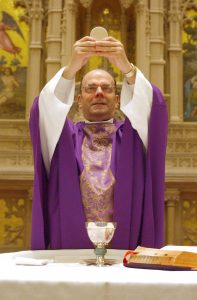
Msgr. Robert Cunningham, then pastor of St. Louis Church in Buffalo, celebrates Mass at the church. (Photo courtesy Buffalo Diocese)
Bishop Cunningham was named pastor of St. Louis Church in Buffalo in 2002, his first pastorate since his ordination 33 years earlier. The downtown parish, Buffalo’s oldest, was founded in 1829 by French and German families. Bishop Cunningham was the parish’s first pastor of Irish descent.
“It was a wonderful experience. I enjoyed it very much,” he said of his time at the parish. “We were able to raise necessary funds to care for the church building,” and the faithful “took great ownership of the church” and its grounds. The parish fed about 70 people a day through a free sandwich program and some 60 weddings were celebrated there each year.
In December 2003, the diocesan College of Consultors elected Bishop Cunningham to serve as administrator of the diocese following Bishop Henry Mansell’s appointment as the Archbishop of the Archdiocese of Hartford, Conn. So when he received a call from the papal nuncio in March 2004, he thought he’d be hearing that a new bishop had been selected for Buffalo.
To his surprise, Archbishop Gabriel Montalvo was calling to tell him Pope John Paul II had named him the Bishop of Ogdensburg.
Sixty years old at the time, Bishop Cunningham had assumed he would spend the rest of his ministry in Buffalo, serving as pastor of St. Louis. Being named a bishop? “I can’t say I was really thinking about that,” he laughed.
Bishop Cunningham was ordained and installed as the bishop of Ogdensburg on May 18, 2004.
“I had a wonderful time in Ogdensburg,” he said. “I loved the people, loved the small towns, loved the scenic beauty.” Once again, he figured he’d spend the remainder of his ministry there. And once again, in 2009, he got a surprising phone call from the nuncio, informing him “the Holy Father desired me to be happy in Syracuse.”
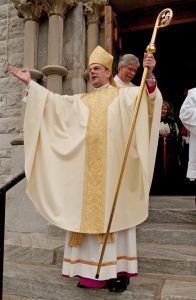
Bishop Cunningham greets the faithful on the steps of the Cathedral of the Immaculate Conception following his installation as bishop of the Diocese of Syracuse May 26, 2009. (Sun photo | Paul Finch)
Bishop Cunningham was installed as the tenth Bishop of Syracuse on May 26, 2009.
Coming into a new diocese, “you’re intrigued by something new, you’re looking forward to new opportunities of serving people,” he said. “You have to depend a lot upon other people because you know nobody, and you have to find your way and try and decide ‘how best can I serve these people?’”
Msgr. Richard Kopp was one of the few priests of the diocese Bishop Cunningham knew before arriving in Syracuse. The two had come to know one another through their service as chancellor in their respective dioceses.
Msgr. Kopp, who currently serves as diocesan Vicar for Priests, said he was delighted when he heard Bishop Cunningham had been appointed to Syracuse.
Describing the bishop as kind, understanding, gentle, and forgiving, Msgr. Kopp said, all around, “he’s very affirming and extremely easy to work for.” And while he has a great sense of humor, Bishop Cunningham “is very serious about listening to all points of view. It doesn’t matter where it’s coming from, he listens to it,” Msgr. Kopp said.

Bishop Cunningham gets some last-minute instructions before his installation Mass from Communications Director Danielle Cummings. (Sun photo | Paul Finch)
Another close advisor to the bishop is Danielle Cummings. She has served as diocesan Director of Communications since 1996; Bishop Cunningham named her chancellor in 2015, the first woman and first layperson in the diocese’s history to hold the position.
“There’s a short line of folks who have an opportunity to get to know a bishop well and I’ve been privileged to do so,” she said.
Working with the bishop over the years, Cummings said she has come to know him as a strong communicator of the good news, a source of strength, and a sometimes emotional Irishman — though getting to know him took some time. In his early days in the diocese, Bishop Cunningham was more reserved, she said. But at his installation, seeing him surrounded by family and coming to know how close he is to them, “that’s where you see the fullness of Bishop Cunningham.”
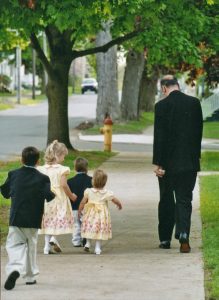
Bishop Cunningham walks in Ogdensburg with just a few of his 30 great-nieces and great-nephews. (Photo provided)
Bishop Cunningham is better known as Uncle Bob to 13 nieces and nephews and 30 grandnieces and grandnephews.
Niece K.C. Kappell describes her uncle as personable and funny, noting “how gentle he is and how much he makes all of us feel good about ourselves…. It’s very easy to be yourself when you’re with him.” Bishop Cunningham celebrated Kappell’s marriage to her husband Rob, who was raised in the Jewish faith. Uncle Bob “always wanted the ceremony to be about the both of us,” she said, and he worked with the couple to make sure they both felt comfortable.
Colleen Burns agrees with her sister’s assessment of their uncle, her godfather. He’s kind, sincere, and easy-going, she said — except when it comes to playing Phase 10, a card game. Then “it’s every man for himself,” Burns laughed.
As he reflected on his half-century of ministry, Bishop Cunningham recalled a moment just a bit further back in time: “In May of 1968 I was ordained a deacon. A week later I was asked to be the deacon at [Msgr. Charles Klauder’s] 50th anniversary Mass. And I thought, ‘He’s really old.’ And now I’m saying to myself, ‘How did I get this old this quick?’”

Bishop Cunningham presents the first Immaculata Award to Rose Troini of St. Augustine Church in Baldwinsville, accompanied by then-pastor Father Tom Servatius, at the
inaugural celebration of lay volunteers in 2011. (Sun photo | Chuck Wainwright)
Among Bishop Cunningham’s personal highlights from his years in Syracuse: declaring and celebrating in 2017 and 2018 the diocesan Year of the Family and instituting in 2011 the Immaculata Award. Created as part of the diocese’s 125th anniversary celebration, the award is presented annually to volunteers who faithfully serve their parishes. “I thought that there were so many people in parishes working day-to-day on a volunteer basis, the kind of unsung heroes that don’t get a lot of recognition,” he said. Nominees from parishes across the diocese receive the awards at a special liturgy held at the Cathedral. “It’s been a great blessing,” he said.
His years have included painful times as well.
The clergy sexual abuse crisis has been a particularly devastating period in the history of the Church. Bishop Cunningham launched in 2018 an Independent Reconciliation and Compensation Program in the diocese; 79 victim-survivors of sexual abuse by clergy settled their claims and received compensation through the program.
“We realized that no amount of money could ever take away or could ever compensate for the pain and suffering that so many people endured…. We hoped it would be a goodwill effort to bring hope and healing to people who have suffered a great deal,” he said. “I’m happy that we’ve been able to help a number of people in this way and we continue to be concerned for victims on a daily basis. People who have been victimized are never far from my thoughts or prayers.”
Closing churches in the ongoing process of parish reconfiguration has been difficult as well. Bishop Cunningham acknowledges there’s still work yet to be done, noting “we have to recognize that we are a smaller community than we were in the past.”
On May 26, Bishop Cunningham will celebrate the 50th anniversary of his ordination to the priesthood. On June 1, he will ordain the diocese’s newest priest, Nathan Brooks.
“It’s a real thrill to ordain a priest” and an emotional moment as well, the bishop said.
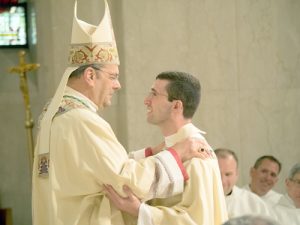
Bishop Cunningham and Father Jason Hage exchange the Sign of Peace at Father Hage’s ordination June 7, 2014. (Sun photo | Chuck Wainwright)
The 18 men he’s ordained over the years are “kind of my legacy,” Bishop Cunningham said. “I know that the good work they do will go on long after I’m gone.”
His time as shepherd of Syracuse is likely nearing its end: Bishop Cunningham turned 75 last June and, as required by canon law, submitted his letter of resignation to the Holy Father. His successor has not yet been named.
“It’ll be an interesting change,” he said of his eventual retirement. He looks forward to moving into the days more slowly, controlling his own calendar, spending more time studying scripture and in prayer. He hopes to help out in parishes and to assist the new bishop — whoever he may be and whenever he may be named — as needed.
As he thinks about his next chapter, how does the bishop hope to be remembered by the people of the Diocese of Syracuse? As someone who cared, he said.
Echoing a sentiment he offered in a video reflection for his jubilee, Bishop Cunningham said, “When Pope Benedict sent me here, he could have sent perhaps a better teacher or preacher or administrator. He could have sent a man with many more talents than I have. But he could not have sent anybody that would have tried to love you more.”




